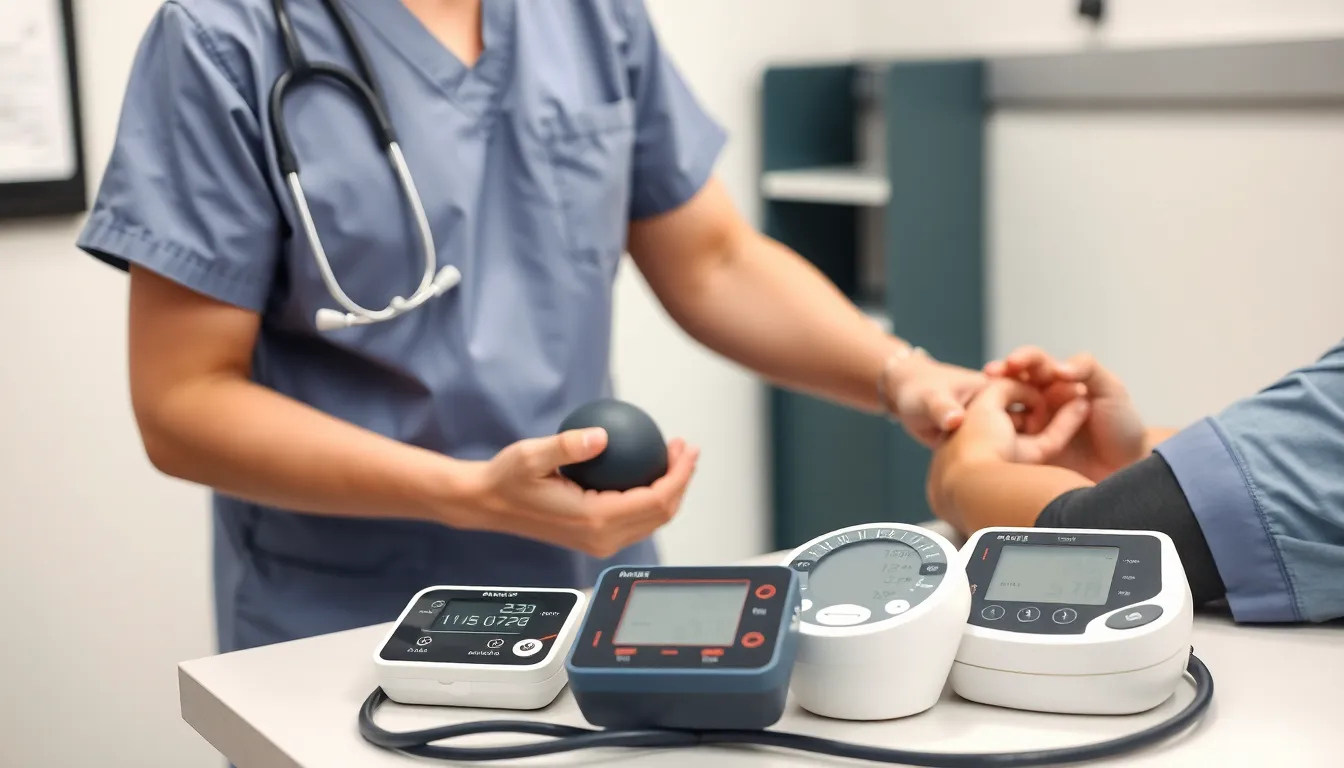Understanding how to read a blood pressure machine is essential for anyone looking to monitor their cardiovascular health. With heart disease being a leading cause of death worldwide, knowing one’s blood pressure can be a crucial step in prevention and management. Blood pressure readings can reveal vital information about overall health, and learning to interpret these numbers empowers individuals to take charge of their well-being.
This guide breaks down the basics of blood pressure readings, making it easier for anyone to understand the numbers displayed on their machine. From systolic and diastolic readings to the importance of pulse rates, mastering these concepts can lead to more informed health decisions. Whether it’s for personal use or monitoring a loved one, knowing how to read a blood pressure machine is a skill worth acquiring.
Table of Contents
ToggleUnderstanding Blood Pressure
Blood pressure measures the force of blood against artery walls. Accurate readings are vital for assessing cardiovascular health.
What Is Blood Pressure?
Blood pressure consists of two key values: systolic pressure and diastolic pressure. Systolic pressure, the higher number, indicates the force during heartbeats. Diastolic pressure, the lower number, reflects the force when the heart is at rest between beats. For example, a reading of 120/80 mmHg shows a systolic pressure of 120 and a diastolic pressure of 80. Normal levels usually range from 90/60 mmHg to 120/80 mmHg. Understanding these values helps individuals gauge their heart health effectively.
Importance of Monitoring Blood Pressure
Monitoring blood pressure serves multiple health benefits. Regular checks can detect hypertension early, a condition affecting nearly 47% of adults in the U.S. Recognizing high blood pressure allows for timely interventions, reducing the risk of heart disease, stroke, and kidney damage. Tracking changes over time helps evaluate the effectiveness of lifestyle changes or medications. Individuals who monitor their blood pressure often take proactive steps to improve overall health and prevent serious complications.
Types of Blood Pressure Machines

Understanding the different types of blood pressure machines aids in selecting the right one for accurate monitoring. The two primary categories are manual and automatic blood pressure monitors.
Manual Blood Pressure Monitors
Manual blood pressure monitors require user operation for accurate readings. They consist of a cuff, a bulb for inflation, and a pressure gauge. Users manually inflate the cuff around the upper arm and listen for heartbeats through a stethoscope to determine systolic and diastolic pressures.
- Apparatus Components: Blood pressure cuff, inflation bulb, and gauge.
- Measurement Method: Requires manual inflation and auscultation.
- Skill Requirement: Proficiency in using a stethoscope is necessary.
- Typical Use: Commonly utilized in clinical and hospital settings.
Automatic Blood Pressure Monitors
Automatic blood pressure monitors provide readings without the need for manual inputs. They use electronic sensors to gauge blood pressure and often display readings on an LCD screen.
- Apparatus Components: Digital cuff and electronic display.
- Measurement Method: Automatic inflation and reading via built-in sensors.
- Ease of Use: User-friendly; suitable for all skill levels.
- Typical Use: Ideal for home monitoring and healthcare settings.
Each type of blood pressure machine offers distinct advantages depending on user preferences and requirements for monitoring health.
How to Read Blood Pressure Machine
Understanding how to read a blood pressure machine is essential for effective cardiovascular monitoring. This knowledge helps individuals interpret their health metrics accurately and take proactive health measures.
Interpreting the Readings
Blood pressure readings consist of two numbers displayed typically in the format of systolic over diastolic, such as 120/80 mmHg. The first number, systolic, indicates the pressure in arteries during heartbeats. The second number, diastolic, shows the pressure when the heart rests between beats. An automatic blood pressure monitor usually displays these values on a digital screen, while a manual monitor requires the observer to read the gauge. Correctly interpreting these values allows individuals to assess their blood pressure status, identifying if it falls within normal, elevated, or hypertensive ranges.
Understanding Systolic and Diastolic Numbers
Systolic and diastolic numbers play critical roles in determining blood pressure health. Systolic pressure, measured when the heart contracts, is vital, as high levels can indicate an increased risk of heart disease. A systolic reading of 130 mmHg or above usually signifies hypertension. Diastolic pressure, measured when the heart is at rest, is equally important. Readings of 80 mmHg or higher can also suggest high blood pressure. Normal blood pressure ranges typically lie between 90/60 mmHg and 120/80 mmHg. Regular monitoring of both values supports early detection of potential health issues and informs necessary lifestyle adjustments or medical treatments.
Common Mistakes in Reading Blood Pressure
Understanding common mistakes in reading blood pressure ensures accuracy in monitoring cardiovascular health. Addressing these errors enhances the effectiveness of blood pressure management.
Incorrect Cuff Size
Using the wrong cuff size significantly impacts blood pressure readings. A cuff that’s too small can result in falsely elevated readings, while a cuff that’s too large may yield inaccurately low readings. It’s essential to select a cuff that fits snugly around the arm, with the bladder covering 80% of the arm’s circumference for optimal accuracy. Proper cuff sizing is critical, especially since manufacturers often provide guidelines based on arm circumference measurements.
Improper Positioning During Measurement
Positioning during measurement influences blood pressure accuracy. Ideal positioning requires sitting comfortably with the back supported, feet flat on the ground, and the arm resting at heart level. Measures taken with the arm hanging down or the body in motion can lead to inconsistent readings. Ensuring stillness during measurement further aids in obtaining reliable results. Adhering to these positioning guidelines promotes more precise blood pressure assessments and aids in effective management of cardiovascular health.
Tips for Accurate Readings
Accurate blood pressure readings depend on proper preparation and awareness of influencing factors. Following guidelines ensures more reliable results.
Preparing for Measurement
Preparing for a blood pressure measurement involves several essential steps to optimize results. Choose a quiet environment free from distractions. Rest for at least five minutes before measuring. Sit upright in a comfortable chair, supporting the back and feet flat on the floor. Roll up any sleeves to allow the cuff to fit snugly around the upper arm. Position the arm so it’s at heart level, either resting on a table or supported by the user. Ensure the cuff fits correctly—too tight or too loose can skew readings. Perform multiple readings, waiting one minute between each for accuracy.
Factors That Affect Blood Pressure Readings
Several factors can influence blood pressure readings significantly. Consider the following:
- Time of Day: Blood pressure varies throughout the day, often lowest in the morning and higher in the evening.
- Physical Activity: Recent exercise can temporarily elevate blood pressure, affecting readings.
- Stress Levels: Anxiety or stress immediately before measuring can cause higher readings.
- Caffeine Intake: Consumption of caffeinated beverages may increase blood pressure temporarily.
- Smoking: Smoking within 30 minutes prior to measurement can lead to elevated readings.
- Body Position: Different positions, like standing or lying down, can affect blood pressure levels.
Awareness of these factors aids in achieving consistent, accurate blood pressure readings.
Understanding how to read a blood pressure machine is vital for maintaining cardiovascular health. By grasping the significance of systolic and diastolic readings individuals can take proactive steps toward better health management. Regular monitoring empowers them to detect potential issues early and make informed decisions regarding lifestyle changes or medical interventions.
Equipped with knowledge about the different types of blood pressure monitors and the importance of accurate readings individuals can ensure they’re effectively tracking their health. Paying attention to factors that influence blood pressure will further enhance the reliability of measurements. Taking these steps not only supports personal well-being but also contributes to a healthier community overall.









